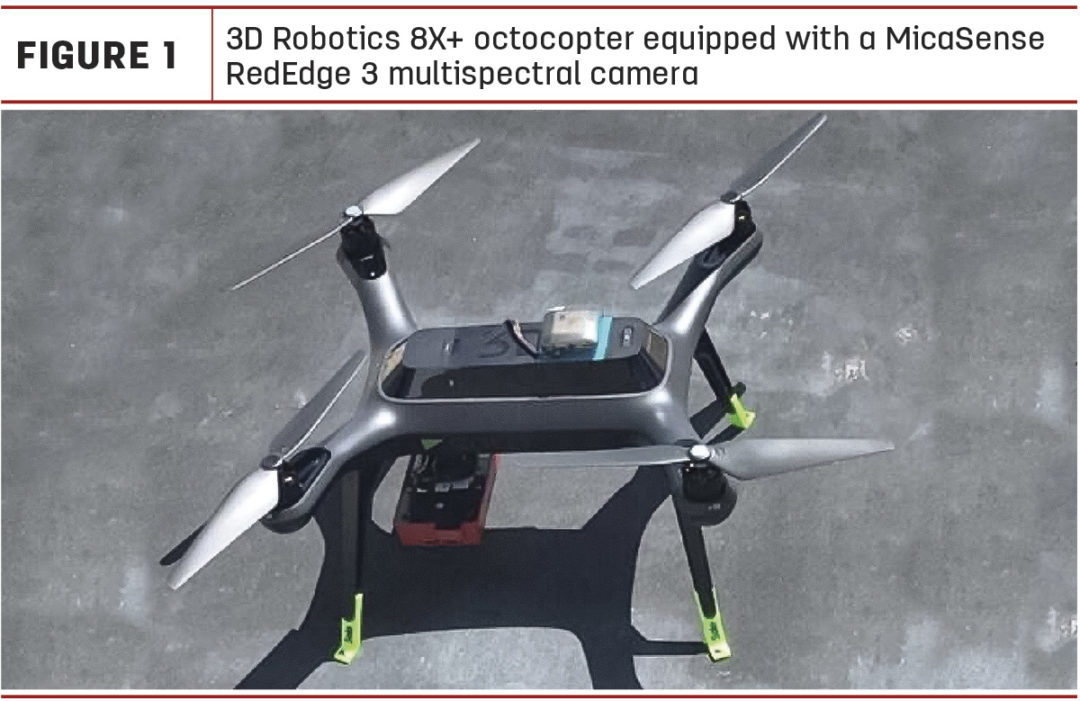Nitrogen (N) can be a yield-limiting nutrient in wheat cropping systems. If used correctly, N fertilization provides one of the largest returns on investment for yield gains and quality enhancement. Prescribing optimal N-rate recommendations is complicated because a tremendous variability of plant-available soil N and crop yield potential exists within or between growing seasons and within or between fields. Precision agriculture (PA) is a concept of monitoring, measuring and responding to spatial and temporal variability.
The PA technologies toolbox includes crop sensors and unmanned aerial vehicles (UAVs). PA technologies enable growers to recognize and measure variations present in fields and to manage fertilizer application with a much finer degree of precision than ever before possible. Accurate prediction of yield and grain quality in season equips growers with important decision-making information for timely adjustments in N fertilizer management for optimized wheat production.
Recently, improving N use efficiency by using crop sensors has gained attention, aiming to optimize N inputs while maintaining or improving yields. Canopy vegetation indices enable us to accurately predict variability in grain yield potential before harvest at a large spatial scale. Previous work has shown that UAV-based images were found valuable for the in-season estimation of crop yield. High spatial and temporal resolution images obtained with UAVs are useful for various agriculture-related purposes. Mounted on the UAVs, sensors and cameras facilitate time-efficient assessment of large fields to evaluate crop characteristics contributing to yield and quality across varied growing environments. Here, we report the results from a 14-site-year field study in spring wheat carried out at five locations across southern Idaho in 2015-17.
The objectives of this study were:
- To assess the feasibility of wheat yield and grain protein content prediction with in-season crop spectral-reflectance measurements, and
- To compare a handheld canopy sensor (GS) and a sensor-equipped UAV for accuracy of wheat yield and grain protein content estimation.
Field trials
Field trials were conducted at five locations in southern Idaho (Aberdeen, Ashton, Parma, Rupert and Soda Springs) in 2015-17. Soft white spring wheat (cv. Alturas) was planted at Parma and hard red spring wheat (cv. Cabernet) at all other sites. Granular urea (46-0-0) was surface broadcasted immediately after planting at five rates (0, 84, 168, 252 and 336 kilograms per hectare / 0, 75, 150, 225 and 300 pounds per acre). Treatments were replicated four times in a randomized complete block design, resulting in a total of 20 plots per location each year (1.52 meters wide by 4.27 meters long / 5 feet by 14 feet). All sites were irrigated every seven-10 days using sprinkler irrigation systems, except at Soda Springs (a dryland site).
Handheld crop sensor
At tillering, biomass production was measured as normalized difference vegetative index (NDVI) using a GreenSeeker (GS) handheld crop sensor by sensing the two middle rows of wheat plants at about 27.5 inches above the crop canopy. At maturity, grain yield was determined by harvesting wheat with a small plot research combine. Grain N concentration was measured with near-infrared (NIR) reflectance spectroscopy. Grain protein concentration was calculated by multiplying grain total N content by 5.7 and was expressed in percent.

Unmanned aerial vehicle
An octocopter UAV 3D Robotics X8+ (Figure 1) was used to carry camera payload to acquire ultra-high-resolution images (Figure 2). The UAV flights were captured at 100 meters (328 feet) above the ground level (AGL) in sunny, cloud-free conditions within two hours of solar noon. Mission planner software was used to form the flight routes and select the sensor parameters to ensure an adequate overlap between the captured images. Two flight missions were performed over each experimental field at tillering and boot growth stages of wheat. These stages were selected because N fertilizer applied at these growth stages has the potential to optimize wheat yield and grain quality, respectively.

A MicaSense RedEdge 3 multispectral camera installed on the UAV was used to obtain the images (Figure 1). Images were imported to MicaSense Atlas software for radiometric calibration, georeferencing and mosaicking. The PIX4Dmapper works by stitching the multiple individual images to produce a single ortho-rectified image that matches the spatial accuracy of a map by considering location and elevation. The mosaicked images were radiometrically calibrated using the RedEdge radiometric calibration model in Atlas software. The calibrated reflectance panel (CRP) was placed at the edge of the research fields during the UAV flights. An image of the CRP was captured immediately before and after each flight.
The relationship between GS NDVI and UAV NDVI and spring wheat yield and grain protein concentration was evaluated.
Results
Table 1 summarizes the Pearson correlation coefficients as a measure of the strength of the association between GS NDVI, UAV NDVI, wheat yield and grain protein content. Wheat yield was most closely correlated with GS NDVI and UAV NDVI at tillering. No obvious relationship between GS NDVI and UAV NDVI with grain protein content was observed.

In this study, we observed a strong positive correlation between GS NDVI and UAV NDVI (Figure 2). Work by Stone et al. has shown that NDVI measurements in wheat at tillering can provide reliable predictions of N uptake and biomass production. Reeves et al. used direct in-season measurements of total N uptake at tillering to predict wheat grain yield.
Our results have confirmed that wheat yield and grain N uptake can be successfully predicted with both GS NDVI and UAV NDVI. We observed a strong linear relationship between GS NDVI and UAV NDVI (0.78), especially at tillering. The GS NDVI and UAV NDVI relationship with wheat yield and N uptake was stronger at tillering compared to flowering. This makes sense because at tillering wheat plant vigor is high, and the majority of N uptake is directed toward biomass (roots, leaves and stems) production. In contrast, at the flowering stage N uptake is shifted in the direction of grain production. We found that neither GS NDVI nor UAV NDVI in-season data were particularly useful in the prediction of wheat grain protein content. The GS NDVI and UAV NDVI correlation with wheat yield and grain N uptake were comparable.
Conclusion
- We found a strong linear relationship was observed between GS NDVI and UAV NDVI.
- Wheat yield was estimated in season with both GS NDVI and UAV NDVI with comparable accuracy.
- Although the GS and UAV NDVI explained less than 50% variation in wheat yield, remote sensing is a promising tool for improving N management in wheat. Click here for detailed information.
- In-season NDVI-based prediction of wheat grain protein remains a challenge.
Acknowledgement: Project was funded by the Idaho Wheat Commission and Idaho wheat producers.
The following authors contributed to this article: Juliet Marshall, department head, department of plant sciences, University of Idaho; Chad Jackson, operations manager, Aberdeen Research and Extension Center, University of Idaho; Ritika Lamichhane, graduate student, Parma Research and Extension Center, University of Idaho; Emmanuella Owusu Ansah, graduate student, Parma Research and Extension Center, University of Idaho; and Eva Nambi, postdoctoral fellow, department of plant sciences, University of Idaho.
References omitted but are available upon request. Click here to email an editor.









